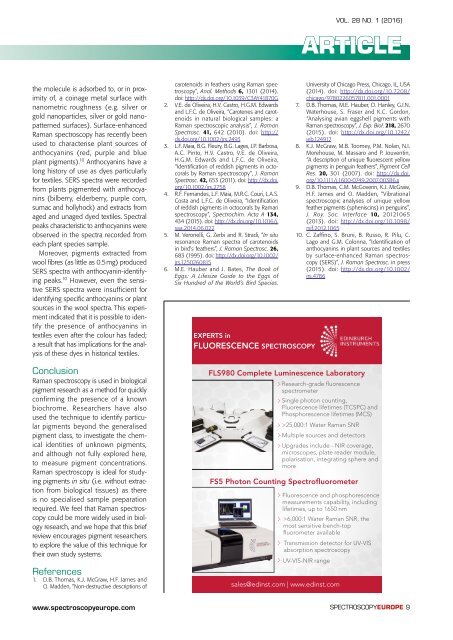Raman spectroscopy of biological pigments Solid mixed matrices in MALDI/TOF-MS
1VpTi1r
1VpTi1r
You also want an ePaper? Increase the reach of your titles
YUMPU automatically turns print PDFs into web optimized ePapers that Google loves.
VOL. 28 NO. 1 (2016)<br />
ARTICLE<br />
the molecule is adsorbed to, or <strong>in</strong> proximity<br />
<strong>of</strong>, a co<strong>in</strong>age metal surface with<br />
nanometric roughness (e.g. silver or<br />
gold nanoparticles, silver or gold nanopatterned<br />
surfaces). Surface-enhanced<br />
<strong>Raman</strong> <strong>spectroscopy</strong> has recently been<br />
used to characterise plant sources <strong>of</strong><br />
anthocyan<strong>in</strong>s (red, purple and blue<br />
plant <strong>pigments</strong>). 10 Anthocyan<strong>in</strong>s have a<br />
long history <strong>of</strong> use as dyes particularly<br />
for textiles. SERS spectra were recorded<br />
from plants pigmented with anthocyan<strong>in</strong>s<br />
(bilberry, elderberry, purple corn,<br />
sumac and hollyhock) and extracts from<br />
aged and unaged dyed textiles. Spectral<br />
peaks characteristic to anthocyan<strong>in</strong>s were<br />
observed <strong>in</strong> the spectra recorded from<br />
each plant species sample.<br />
Moreover, <strong>pigments</strong> extracted from<br />
wool fibres (as little as 0.5 mg) produced<br />
SERS spectra with anthocyan<strong>in</strong>-identify<strong>in</strong>g<br />
peaks. 10 However, even the sensitive<br />
SERS spectra were <strong>in</strong>sufficient for<br />
identify<strong>in</strong>g specific anthocyan<strong>in</strong>s or plant<br />
sources <strong>in</strong> the wool spectra. This experiment<br />
<strong>in</strong>dicated that it is possible to identify<br />
the presence <strong>of</strong> anthocyan<strong>in</strong>s <strong>in</strong><br />
textiles even after the colour has faded;<br />
a result that has implications for the analysis<br />
<strong>of</strong> these dyes <strong>in</strong> historical textiles.<br />
Conclusion<br />
<strong>Raman</strong> <strong>spectroscopy</strong> is used <strong>in</strong> <strong>biological</strong><br />
pigment research as a method for quickly<br />
confirm<strong>in</strong>g the presence <strong>of</strong> a known<br />
biochrome. Researchers have also<br />
used the technique to identify particular<br />
<strong>pigments</strong> beyond the generalised<br />
pigment class, to <strong>in</strong>vestigate the chemical<br />
identities <strong>of</strong> unknown <strong>pigments</strong>,<br />
and although not fully explored here,<br />
to measure pigment concentrations.<br />
<strong>Raman</strong> <strong>spectroscopy</strong> is ideal for study<strong>in</strong>g<br />
<strong>pigments</strong> <strong>in</strong> situ (i.e. without extraction<br />
from <strong>biological</strong> tissues) as there<br />
is no specialised sample preparation<br />
required. We feel that <strong>Raman</strong> <strong>spectroscopy</strong><br />
could be more widely used <strong>in</strong> biology<br />
research, and we hope that this brief<br />
review encourages pigment researchers<br />
to explore the value <strong>of</strong> this technique for<br />
their own study systems.<br />
References<br />
1. D.B. Thomas, K.J. McGraw, H.F. James and<br />
O. Madden, “Non-destructive descriptions <strong>of</strong><br />
carotenoids <strong>in</strong> feathers us<strong>in</strong>g <strong>Raman</strong> <strong>spectroscopy</strong>”,<br />
Anal. Methods 6, 1301 (2014).<br />
doi: http://dx.doi.org/10.1039/C3AY41870G<br />
2. V.E. de Oliveira, H.V. Castro, H.G.M. Edwards<br />
and L.F.C. de Oliveira, “Carotenes and carotenoids<br />
<strong>in</strong> natural <strong>biological</strong> samples: a<br />
<strong>Raman</strong> spectroscopic analysis”, J. <strong>Raman</strong><br />
Spectrosc. 41, 642 (2010). doi: http://<br />
dx.doi.org/10.1002/jrs.2493<br />
3. L.F. Maia, B.G. Fleury, B.G. Lages, J.P. Barbosa,<br />
A.C. P<strong>in</strong>to, H.V. Castro, V.E. de Oliveira,<br />
H.G.M. Edwards and L.F.C. de Oliveira,<br />
“Identification <strong>of</strong> reddish <strong>pigments</strong> <strong>in</strong> octocorals<br />
by <strong>Raman</strong> <strong>spectroscopy</strong>”, J. <strong>Raman</strong><br />
Spectrosc. 42, 653 (2011). doi: http://dx.doi.<br />
org/10.1002/jrs.2758<br />
4. R.F. Fernandes, L.F. Maia, M.R.C. Couri, L.A.S.<br />
Costa and L.F.C. de Oliveira, “Identification<br />
<strong>of</strong> reddish <strong>pigments</strong> <strong>in</strong> octocorals by <strong>Raman</strong><br />
<strong>spectroscopy</strong>”, Spectrochim. Acta A 134,<br />
434 (2015). doi: http://dx.doi.org/10.1016/j.<br />
saa.2014.06.022<br />
5. M. Veronelli, G. Zerbi and R. Stradi, “In situ<br />
resonance <strong>Raman</strong> spectra <strong>of</strong> carotenoids<br />
<strong>in</strong> bird’s feathers”, J. <strong>Raman</strong> Spectrosc. 26,<br />
683 (1995). doi: http://dx.doi.org/10.1002/<br />
jrs.1250260815<br />
6. M.E. Hauber and J. Bates, The Book <strong>of</strong><br />
Eggs: A Lifesize Guide to the Eggs <strong>of</strong><br />
Six Hundred <strong>of</strong> the World’s Bird Species.<br />
EXPERTS <strong>in</strong><br />
FLUORESCENCE SPECTROSCOPY<br />
sales@ed<strong>in</strong>st.com | www.ed<strong>in</strong>st.com<br />
University <strong>of</strong> Chicago Press, Chicago, IL, USA<br />
(2014). doi: http://dx.doi.org/10.7208/<br />
chicago/9780226057811.001.0001<br />
7. D.B. Thomas, M.E. Hauber, D. Hanley, G.I.N.<br />
Waterhouse, S. Fraser and K.C. Gordon,<br />
“Analys<strong>in</strong>g avian eggshell <strong>pigments</strong> with<br />
<strong>Raman</strong> <strong>spectroscopy</strong>”, J. Exp. Biol. 218, 2670<br />
(2015). doi: http://dx.doi.org/10.1242/<br />
jeb.124917<br />
8. K.J. McGraw, M.B. Toomey, P.M. Nolan, N.I.<br />
Morehouse, M. Massaro and P. Jouvent<strong>in</strong>,<br />
“A description <strong>of</strong> unique fluorescent yellow<br />
<strong>pigments</strong> <strong>in</strong> pengu<strong>in</strong> feathers”, Pigment Cell<br />
Res. 20, 301 (2007). doi: http://dx.doi.<br />
org/10.1111/j.1600-0749.2007.00386.x<br />
9. D.B. Thomas, C.M. McGover<strong>in</strong>, K.J. McGraw,<br />
H.F. James and O. Madden, “Vibrational<br />
spectroscopic analyses <strong>of</strong> unique yellow<br />
feather <strong>pigments</strong> (sphenisc<strong>in</strong>s) <strong>in</strong> pengu<strong>in</strong>s”,<br />
J. Roy. Soc. Interface 10, 20121065<br />
(2013). doi: http://dx.doi.org/10.1098/<br />
rsif.2012.1065<br />
10. C. Zaff<strong>in</strong>o, S. Bruni, B. Russo, R. Pilu, C.<br />
Lago and G.M. Colonna, “Identification <strong>of</strong><br />
anthocyan<strong>in</strong>s <strong>in</strong> plant sources and textiles<br />
by surface-enhanced <strong>Raman</strong> <strong>spectroscopy</strong><br />
(SERS)”, J. <strong>Raman</strong> Spectrosc. <strong>in</strong> press<br />
(2015). doi: http://dx.doi.org/10.1002/<br />
jrs.4786<br />
FLS980 Complete Lum<strong>in</strong>escence Laboratory<br />
Research-grade fluorescence<br />
spectrometer<br />
S<strong>in</strong>gle photon count<strong>in</strong>g,<br />
Fluorescence lifetimes (TCSPC) and<br />
Phosphorescence lifetimes (MCS)<br />
>25,000:1 Water <strong>Raman</strong> SNR<br />
Multiple sources and detectors<br />
Upgrades <strong>in</strong>clude - NIR coverage,<br />
microscopes, plate reader module,<br />
polarisation, <strong>in</strong>tegrat<strong>in</strong>g sphere and<br />
more<br />
FS5 Photon Count<strong>in</strong>g Spectr<strong>of</strong>luorometer<br />
Fluorescence and phosphorescence<br />
measurements capability, <strong>in</strong>clud<strong>in</strong>g<br />
lifetimes, up to 1650 nm<br />
>6,000:1 Water <strong>Raman</strong> SNR, the<br />
most sensitive bench-top<br />
fluorometer available<br />
Transmission detector for UV-VIS<br />
absorption <strong>spectroscopy</strong><br />
UV-VIS-NIR range<br />
www.<strong>spectroscopy</strong>europe.com<br />
SPECTROSCOPYEUROPE 9


